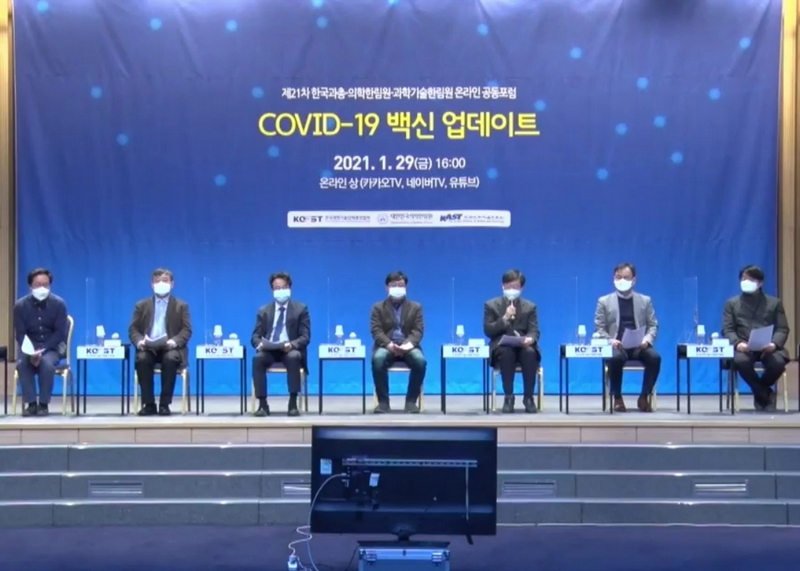Although it is decreasing little by little, the corona19 epidemic has not seldom stopped, and the health authorities recently announced the former national vaccination plan. The key to the vaccination plan is that in the first half of this year, all high-risk groups of Corona 19 will be vaccinated, and in the second half, 30 million adults over the age of 19 will be vaccinated within three months.
With the announcement of the specific COVID-19 vaccination plan, the’Corona 19 Vaccine Update’ was held online on the 29th of last month to discuss effective vaccine supply strategies, attracting attention.

An online event was held to discuss effective vaccine supply measures. ⓒ YouTube video capture
This event, co-hosted by the Korean Federation of Science and Technology Societies (hereinafter referred to as the National Federation of Science and Technology), the Academy of Medicine, and the Academy of Science and Technology, was prepared to share clinical measures and future vaccination plans for the outbreak of the mutant coronavirus.
Public health officials announced plans for vaccination
Choi Won-seok, a professor of infectious medicine at Korea Medical University, who gave a presentation on the subject of’Corona 19 Vaccination Strategy’ said, “The vaccine supply plan has been confirmed, but when we divide this year into the first half and the second half, the supply will not be much in the first half “Probably, in the third quarter, there will be room for several vaccines to be supplied at the same time.”
According to the’Corona 19 Vaccination Plan’ announced by the health authorities, vaccinations by medical staff begin in February and vaccinations by residents and workers such as nursing hospitals in the first quarter, and vaccinations by senior citizens aged 65 years or older and officials from medical institutions in the second quarter Appeared to be.
Subsequently, in the third quarter, chronically ill and adults aged 19 to 64 were vaccinated, and in the fourth quarter, secondary vaccinations and non-vaccinated people received the vaccine, and thus 70% of the total population will be vaccinated by November. Plan.
In response, Professor Choi predicts, “From the second half of the year, we will expand vaccination targets to all citizens by comprehensively considering the vaccine introduction schedule and the expected vaccination situation in the first half.” In case it is adjusted to the last ranking,” he added.

Corona 19 vaccination system ⓒ Korea Centers for Disease Control and Prevention
Looking at the COVID-19 vaccination system released by the Korea Centers for Disease Control and Prevention, it was found that starting with the introduction of the vaccine, which is the first step, distribution, supply, and vaccination are performed in steps 2 and 3, respectively. And it was found that in the last 4 steps, adverse reactions were managed to prevent side effects from occurring.
In fact, a side effect that occurs after vaccination is when an antibody with low neutralizing ability is produced after vaccination with a vaccine in which the virus is inactivated. Representative examples include vaccine associated enhanced respiratory disease (VAERD) or antibody-dependent enhancement (ADE).
It is a vaccine that is vaccinated to avoid infectious diseases, but when VAERD or ADE phenomenon occurs, side effects that can cause serious illness occur. Therefore, Professor Choi argues that the problem of these vaccine side effects should be solved with additional clinical studies.
Professor Choi explained, “The reason for getting the vaccine is to increase population immunity so that the virus does not spread to people without immunity,” said Professor Choi. “However, if there is distrust about the vaccine, even if the next more effective vaccine is released, Refusing to receive vaccination because of disbelief in Korea increases the likelihood that the infectious disease will worsen again.”
Adverse reaction monitoring to minimize vaccine side effects
The reason for getting the vaccine is to increase collective immunity, but increasing collective immunity does not necessarily end the virus outbreak. As the collective immunity increases, the infectivity weakens and the likelihood of infection only decreases.
In this regard, Professor Choi said, “The realistic goal of the corona 19 vaccination is to reduce the chances of infection in high-risk groups.” “The scale of the outbreak should be reduced by lowering the value of Rt through social distancing and wearing a mask. I can make it difficult.”
Professor Choi’s concern is how much the difference is in terms of effectiveness and stability depending on the characteristics of the vaccine. As far as is known, Pfizer and Moderna vaccines were developed based on mRNA, and AstraZeneca and Janssen vaccines are known to be based on viral vectors.

Comparison of characteristics by vaccine type ⓒ Korea Medical University
Meanwhile, it was found that the work of the COVID-19 vaccination safety management system determined by the health authorities is divided into monitoring of adverse reactions, rapid response and epidemiological investigation, and national compensation for vaccination damage and result analysis.
Adverse reaction monitoring activities actively monitor adverse reactions, and vaccination damage investigation teams are operated for rapid response and epidemiological investigations. In addition, for the national compensation for vaccination damage, a special committee for compensation for vaccination damage is held, and the results of epidemiological investigations are confirmed in the analysis of the results.
Professor Choi exchanged opinions with online attendees on how the corona19 epidemic would unfold when vaccination began in earnest. On the premise that it is difficult to predict, he predicted, “It is highly likely that the current situation will continue until at least the first half.”
Prof. Choi said, “In the case of Corona 19, there are too many uncertainties so that it is difficult to predict.”
(591)
